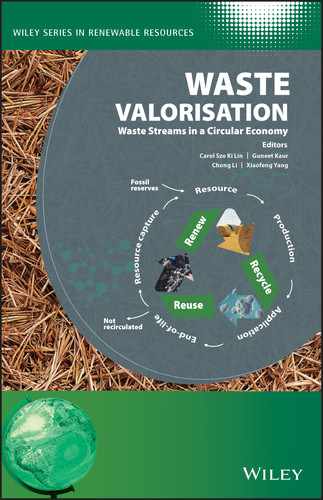A guide to the wide-variety of waste valorisation techniques related to various biomass, waste materials and by products Waste Valorisation provides a comprehensive review of waste chemistry and its application to the generation of value-added products. The authors – noted experts on the topic – offer a clear understanding of waste diversity, drivers and policies governing its valorisation based on the location. The book provides information on the principles behind various valorisation schemes and offers a description of general treatment options with their evaluation guidelines in terms of cost, energy consumption and waste generation. Each of the book's chapters contain an introduction which summarises the current production and processing methods, yields, energy sources and other pertinent information for each specific type of waste. The authors focus on the most relevant novel technologies for value-added processing of waste streams or industrial by-products which can readily be integrated into current waste management systems. They also provide the pertinent technical, economic, social and environmental evaluations of bioconversions as future sustainable technologies in a biorefinery. This important book: Written for academic researchers and industrial scientists working in agricultural and food production, bioconversions and waste management professionals, Waste Valorisation is an authoritative guide to the chemistry and applications of waste materials and provides an overview of the most recent developments in the field.
Table of Contents
- Cover
- List of Contributors
- Series Preface
- Preface
- 1 Overview of Waste Valorisation Concepts from a Circular Economy Perspective
- 2 Waste as a Bioresource
- 2.1 Introduction
- 2.2 Waste Streams and Their Suitability as Feedstock for Valorisation: Is All Waste a Resource?
- 2.3 (Bio)diversity and Variability of Waste Feedstock
- 2.4 Drivers, Policies and Markets for Value‐added Waste‐derived Products
- 2.5 Conclusions and Future Trends
- Acknowledgements
- References
- 3 Treatment of Waste
- 3.1 Introduction
- 3.2 Solid Waste Management
- 3.3 General Approach for Waste Treatment and Conversion to Value‐added Products: Biochemical, Mechanical, and Thermochemical
- 3.4 Factors Influencing Selection of an Appropriate Valorisation Technique for Specific Waste Types
- 3.5 Conventional and Novel Techniques: Overall Comparison in Terms of Energy Consumption, Waste Stream Generation and Cost
- 3.6 Energy Consumption, Waste Stream Generation, and Costs of Conventional and Novel Waste Treatment Technologies
- 3.7 Conclusions and Future Trends
- Acknowledgement
- References
- 4 Valorisation of Agricultural Waste Residues
- 4.1 Introduction
- 4.2 Agricultural Waste Definition, Composition, Variability, and Associated Policies and Regulations
- 4.3 Conventional Techniques – Anaerobic Digestion, Pyrolysis, Gasification, and Solvent Treatment/Extraction
- 4.4 Novel Techniques and Envisioned Product Streams: A New Perspective
- 4.5 Case Study: Yard Waste Management
- 4.6 Conclusions and Future Trends
- Acknowledgements
- References
- 5 Valorisation of Woody Biomass
- 6 Recovery of Nutrients and Transformations of Municipal/Domestic Food Waste
- 6.1 Introduction
- 6.2 Characteristics of Food Waste and its Supply Chain
- 6.3 Recovery of Valuable Products from Anaerobic Digestion of Food Waste
- 6.4 Novel Approaches and Obtainable Products: Biotechnological Processes and Chemical Transformations
- 6.5 Case Study: Production of Methane via Anaerobic Digestion of Food Waste
- 6.6 Conclusions and Future Trends
- References
- 7 Bioconversion of Processing Waste from Agro‐Food Industries to Bioethanol: Creating a Sustainable and Circular Economy
- 8 Challenges with Biomass Waste Valorisation
- 8.1 Introduction
- 8.2 The Pre‐Preparation Technologies of Biomass Waste
- 8.3 Handling of Emerging Biomass Wastes by Newly Developed Techniques
- 8.4 Transforming Biomass Waste to Cellulose by New Techniques
- 8.5 Transforming Biomass Waste to Lignin by New Technologies
- 8.6 Conclusions and Future Trends
- Acknowledgements
- References
- 9 Life cycle Approaches for Evaluating Textile Biovalorisation Processes: Sustainable Decision‐making in a Circular Economy
- 10 Circular Waste‐Based Biorefinery Development
- 10.1 Introduction
- 10.2 Transitioning from Current Linear to Stronger Circular Economy Models
- 10.3 Case Study 1: Circular Textile Waste‐based Biorefinery for Production of Chemicals, Materials, and Fuels
- 10.4 Case Study 2: Circular Food Waste‐based Biorefinery for Production of Chemicals, Materials, and Fuels
- 10.5 Conclusions and Future Trends
- Acknowledgements
- References
- Index
- End User License Agreement
